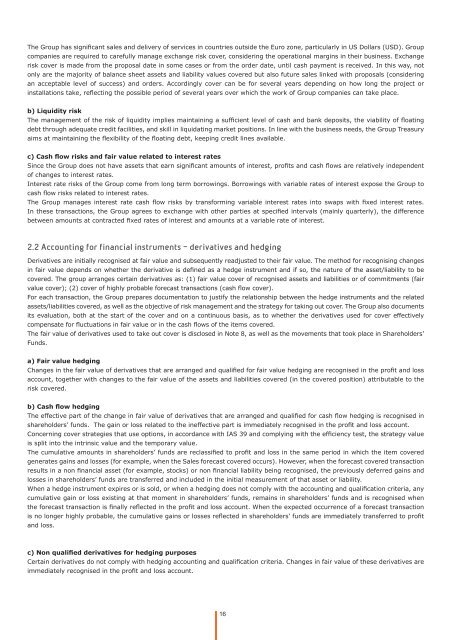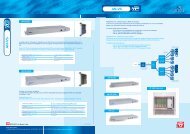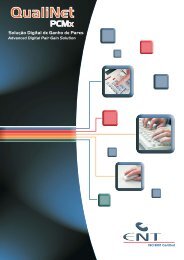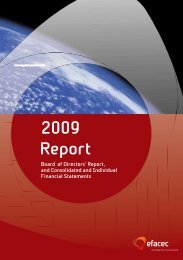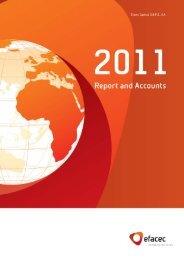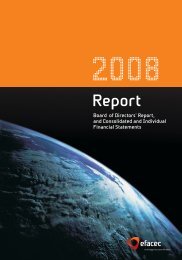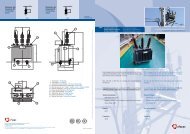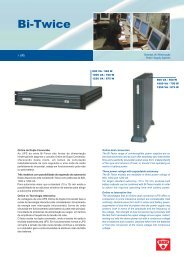Notes to the Financial Statements - Efacec
Notes to the Financial Statements - Efacec
Notes to the Financial Statements - Efacec
Create successful ePaper yourself
Turn your PDF publications into a flip-book with our unique Google optimized e-Paper software.
The Group has signifi cant sales and delivery of services in countries outside <strong>the</strong> Euro zone, particularly in US Dollars (USD). Group<br />
companies are required <strong>to</strong> carefully manage exchange risk cover, considering <strong>the</strong> operational margins in <strong>the</strong>ir business. Exchange<br />
risk cover is made from <strong>the</strong> proposal date in some cases or from <strong>the</strong> order date, until cash payment is received. In this way, not<br />
only are <strong>the</strong> majority of balance sheet assets and liability values covered but also future sales linked with proposals (considering<br />
an acceptable level of success) and orders. Accordingly cover can be for several years depending on how long <strong>the</strong> project or<br />
installations take, refl ecting <strong>the</strong> possible period of several years over which <strong>the</strong> work of Group companies can take place.<br />
b) Liquidity risk<br />
The management of <strong>the</strong> risk of liquidity implies maintaining a suffi cient level of cash and bank deposits, <strong>the</strong> viability of fl oating<br />
debt through adequate credit facilities, and skill in liquidating market positions. In line with <strong>the</strong> business needs, <strong>the</strong> Group Treasury<br />
aims at maintaining <strong>the</strong> fl exibility of <strong>the</strong> fl oating debt, keeping credit lines available.<br />
c) Cash fl ow risks and fair value related <strong>to</strong> interest rates<br />
Since <strong>the</strong> Group does not have assets that earn signifi cant amounts of interest, profi ts and cash fl ows are relatively independent<br />
of changes <strong>to</strong> interest rates.<br />
Interest rate risks of <strong>the</strong> Group come from long term borrowings. Borrowings with variable rates of interest expose <strong>the</strong> Group <strong>to</strong><br />
cash fl ow risks related <strong>to</strong> interest rates.<br />
The Group manages interest rate cash fl ow risks by transforming variable interest rates in<strong>to</strong> swaps with fi xed interest rates.<br />
In <strong>the</strong>se transactions, <strong>the</strong> Group agrees <strong>to</strong> exchange with o<strong>the</strong>r parties at specifi ed intervals (mainly quarterly), <strong>the</strong> difference<br />
between amounts at contracted fi xed rates of interest and amounts at a variable rate of interest.<br />
2.2 Accounting for financial instruments – derivatives and hedging<br />
Derivatives are initially recognised at fair value and subsequently readjusted <strong>to</strong> <strong>the</strong>ir fair value. The method for recognising changes<br />
in fair value depends on whe<strong>the</strong>r <strong>the</strong> derivative is defi ned as a hedge instrument and if so, <strong>the</strong> nature of <strong>the</strong> asset/liability <strong>to</strong> be<br />
covered. The group arranges certain derivatives as: (1) fair value cover of recognised assets and liabilities or of commitments (fair<br />
value cover); (2) cover of highly probable forecast transactions (cash fl ow cover).<br />
For each transaction, <strong>the</strong> Group prepares documentation <strong>to</strong> justify <strong>the</strong> relationship between <strong>the</strong> hedge instruments and <strong>the</strong> related<br />
assets/liabilities covered, as well as <strong>the</strong> objective of risk management and <strong>the</strong> strategy for taking out cover. The Group also documents<br />
its evaluation, both at <strong>the</strong> start of <strong>the</strong> cover and on a continuous basis, as <strong>to</strong> whe<strong>the</strong>r <strong>the</strong> derivatives used for cover effectively<br />
compensate for fl uctuations in fair value or in <strong>the</strong> cash fl ows of <strong>the</strong> items covered.<br />
The fair value of derivatives used <strong>to</strong> take out cover is disclosed in Note 8, as well as <strong>the</strong> movements that <strong>to</strong>ok place in Shareholders’<br />
Funds.<br />
a) Fair value hedging<br />
Changes in <strong>the</strong> fair value of derivatives that are arranged and qualifi ed for fair value hedging are recognised in <strong>the</strong> profi t and loss<br />
account, <strong>to</strong>ge<strong>the</strong>r with changes <strong>to</strong> <strong>the</strong> fair value of <strong>the</strong> assets and liabilities covered (in <strong>the</strong> covered position) attributable <strong>to</strong> <strong>the</strong><br />
risk covered.<br />
b) Cash fl ow hedging<br />
The effective part of <strong>the</strong> change in fair value of derivatives that are arranged and qualifi ed for cash fl ow hedging is recognised in<br />
shareholders’ funds. The gain or loss related <strong>to</strong> <strong>the</strong> ineffective part is immediately recognised in <strong>the</strong> profi t and loss account.<br />
Concerning cover strategies that use options, in accordance with IAS 39 and complying with <strong>the</strong> effi ciency test, <strong>the</strong> strategy value<br />
is split in<strong>to</strong> <strong>the</strong> intrinsic value and <strong>the</strong> temporary value.<br />
The cumulative amounts in shareholders’ funds are reclassifi ed <strong>to</strong> profi t and loss in <strong>the</strong> same period in which <strong>the</strong> item covered<br />
generates gains and losses (for example, when <strong>the</strong> Sales forecast covered occurs). However, when <strong>the</strong> forecast covered transaction<br />
results in a non fi nancial asset (for example, s<strong>to</strong>cks) or non fi nancial liability being recognised, <strong>the</strong> previously deferred gains and<br />
losses in shareholders’ funds are transferred and included in <strong>the</strong> initial measurement of that asset or liability.<br />
When a hedge instrument expires or is sold, or when a hedging does not comply with <strong>the</strong> accounting and qualifi cation criteria, any<br />
cumulative gain or loss existing at that moment in shareholders’ funds, remains in shareholders’ funds and is recognised when<br />
<strong>the</strong> forecast transaction is fi nally refl ected in <strong>the</strong> profi t and loss account. When <strong>the</strong> expected occurrence of a forecast transaction<br />
is no longer highly probable, <strong>the</strong> cumulative gains or losses refl ected in shareholders’ funds are immediately transferred <strong>to</strong> profi t<br />
and loss.<br />
c) Non qualifi ed derivatives for hedging purposes<br />
Certain derivatives do not comply with hedging accounting and qualifi cation criteria. Changes in fair value of <strong>the</strong>se derivatives are<br />
immediately recognised in <strong>the</strong> profi t and loss account.<br />
16


